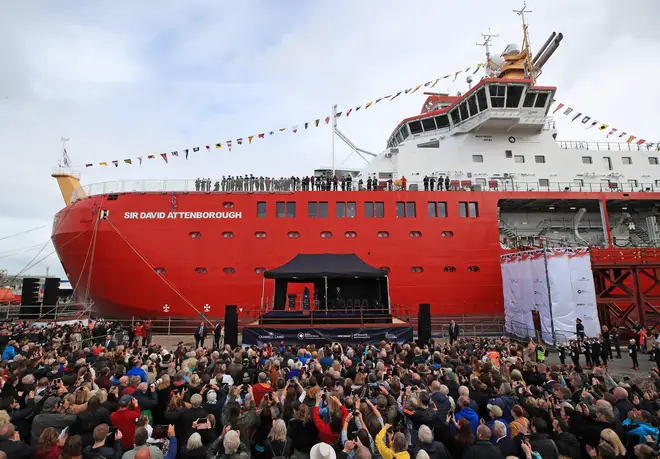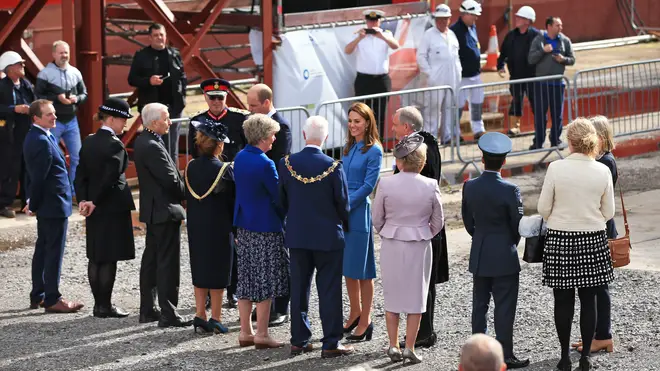
Ian Payne 4am - 7am
26 September 2019, 16:25
The Duke and Duchess of Cambridge officially named the UK's new polar research ship the Sir David Attenborough in a ceremony today.
Despite a public vote to name the vessel "Boaty McBoatface" the ship was named after one of the UK's best-known broadcasters, Sir David Attenborough.
The naturalist joined the royals in the naming ceremony in which the boat was officially christened by the smashing of a bottle of champagne on its bow.
The Duchess was due to initiate the old naval tradition by pressing a giant button set up on the stage from where she gave her speech.
However, the bottle was prematurely smashed in what was otherwise a smooth launch for the RSS Sir David Attenborough.

In her speech, Kate said: "It gives me great pleasure to name this ship 'Sir David Attenborough and may God bless her and all those who sail in her.
Sir David was also welcomed to the stage for an opportunity to address the audience ahead of the vessel's launch, where he took the opportunity to briefly address environmental issues facing the planet.
"Your Royal Highness, ladies and gentlemen. It's no news to any of you that the world at the moment is facing great, great problems and the most aware of that are the young people of today who will inherit this world," he said.
"Great problems require great research and facts in order to solve them.
"That's what this astonishing ship will be here to do; to find out the facts and find the science with which to deal with problems that are facing the world today and will increasingly do so tomorrow."
He added that it was the "greatest possible honour" to have the ship named after him.

Prince William echoed the broadcaster's sentiments, saying the ship would be "important" in addressing problems related to climate change.
He said: "As last week's climate protests the world over and yesterday's report on our oceans and frozen regions demonstrated, there has never been a more important moment for this ship to get to work, and there is no person more fitting for this beacon of scientific research to be named after than you, David.
"You have shown us how awe-inspiring the natural world is, and also how fragile and endangered it is, and you have inspired us all to do as much as we possibly can to protect it.
"It is my immense privilege and relief to welcome Sir David Attenborough, rather than Boaty McBoatface, to speak."
William and Kate toured the ship at the Cammell Laird shipyard in Birkenhead, Merseyside, alongside Sir David to see the state-of-the-art equipment on board.
The group met engineers, scientists, the ship's captain and young apprentices who helped to build the vessel with its ice-breaking capabilities and navigation systems.

The £200m boat will be used as a "floating research fleet" which will help scientists study and explore the world's oceans and the effect of climate change on our planet's waters.
The Natural Environment Research Council commissioned the ship, which houses boundary-pushing equipment that will allow researchers to remotely deploy robotic instruments to areas humans cannot access.
The "Sir David Attenborough" replaces two other polar research ships that have come to the end of their lifespan: the RSS James Clark Ross and the RRS Ernest Shackleton.
It is more fuel efficient and hopes to save more than £100 million in operating costs over its 30-year lifespan in which it will operate in both the Arctic and Antarctica.
It weighs roughly 10,400 tonnes, the equivalent of 1,400 elephants combined, and houses specialist scientific equipment that will allow researchers to study the ocean, seafloor and atmosphere.
Robotic submarines and marine gliders will gather information on ocean conditions and marine life for scientists working in the ship's on-board laboratories
Airborne robots and environmental monitoring systems will also provide data on the surrounding environment.
Other features include an ice-strengthened hull designed to break through ice up to one metre thick, and a "moon pool" - a 4m by 4m vertical shaft running through the vessel that allows instruments to be deployed through an opening in the hull rather than over the side.
Measuring 129m long, it is made up of one million pieces of steel and has 30km (18.6 miles) of piping and 750km (466 miles) of electrical and data cables.
The ship has beds for up to 30 crew and 60 scientists and support staff and can deploy and recover large remotely-operated marine vehicles.